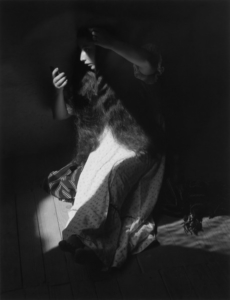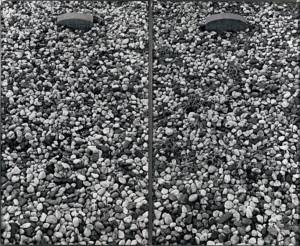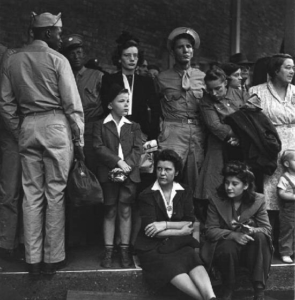Written by GW trainee, Micky Esteban
How does a captured image reflect identity, both past and present? GroundWorks Executive Artistic Director David Shimotakahara premiers a new work for the company’s second year performing at the Akron Art Museum inspired by five acclaimed photographs from the museum’s permanent collection. The company’s collaboration with the museum, funded through a Knight Foundation Arts Challenge Award, aims to make new work in response to pieces in the museum’s permanent collection. The photographers and photos selected were:
- Manuel Alvarez Bravo – Retrato de lo Eterno (Portrait of the Eternal)
- Esther Bubley – Memphis Tennessee – Passengers waiting for a bus at the Greyhound bus terminal
- Sophie Calle – Les Tombes #17 (The Graves)Mother, Father
- Adam Fuss – From the series My Ghost [swan]
- Carrie Mae Weens – Untitledfrom the Kitchen Tables Series (Woman with friends)
On the surface, these five artists are incredibly different in just about every way, from their backgrounds to their aesthetic choices to their choice of subjects. However, Shimotakahara was able to find a common thread through each of their works.
“I found different things in each of their work—I mean, they are all really different! I would say that the starting place with me was through Adam Fuss’s work—probably a combination of him and Manuel Alvarez Bravo, because of their interest in these ideas of life and death. The way they approach those ideas is so different and so fascinating,” said Shimotakahara.
From that starting point, overarching themes of the passage of time, beginning, and ending drove Shimotakahara’s interest in the pictures he chose to respond to.
“I saw the picture of the tombstones [Sophie Calle, Les Tombes #17] and it just made me think of the question—what are life’s markers? What are the moments in our life that are significant and how are they framed? And so when you think about the experience of life that way, that’s what each of these artists are trying to make us aware of–these are the things that we carry with us and make us who we are. That’s how we connect.”These questions were present in the creative process with the company, as each dancer generated short movement studies in response to one of the five photographs. These personal studies were then shared through a variety of modes—teaching to others, intersecting phrases, or interjecting someone else’s movement into an existing phrase. Each dancer’s personal reaction was shared and combined so many times that it became something that the entire company knew and carried together.
Additionally, Shimotakahara’s new work dives deeper into the relationship between time, identity, and change, and how each factor influences the other. The creative process was also influenced, in part, by Shimotakahara’s own reflection of these ideas.
“I’ve been thinking a lot about life cycle. I’m reaching this point in my life where I’m able to look back and have a different perspective on things, places, experiences, people that have changed over time,” he says, “and I’ve been thinking a lot about how do you sort of emerge over time. How do you come to be? How do all these things that sort of build up over time make you?”






